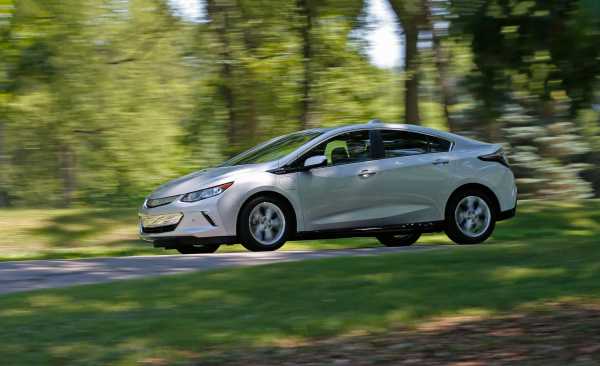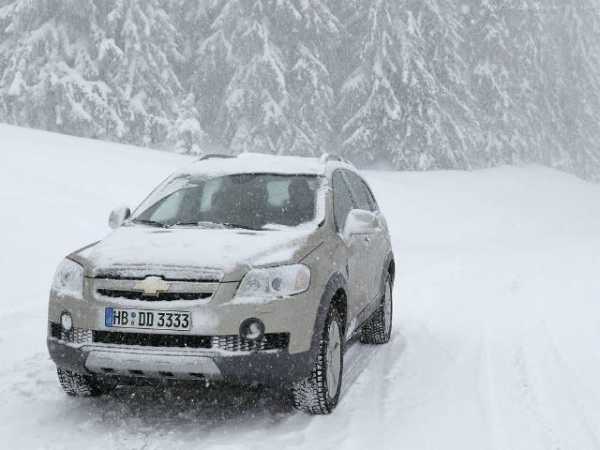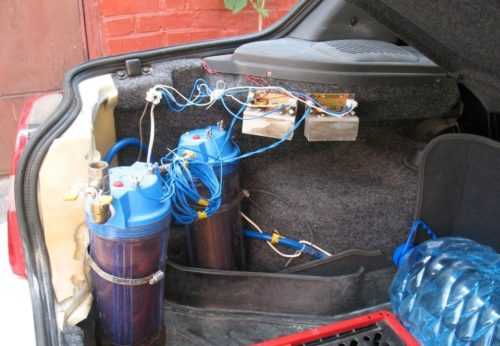Chevy volt ev
THE ALL-ELECTRIC 2018 BOLT EV
1. 2018 Bolt EV and Volt energy consumption and range ratings based on GM testing in accordance with Government of Canada approved test methods. Refer to vehicles.nrcan.gc.ca for details. Full charge required. Actual consumption, driving range and energy cost will vary based on temperature, driving conditions, use of HVAC and/or accessories, and how you drive and maintain your vehicle.
2. Based on initial vehicle movement and GM testing.
3. Provincial electric vehicle incentive (”Incentive”) referenced is a maximum incentive or rebate amount provided by the provincial governments of British Columbia or Quebec (each a ”Province”) on eligible vehicles. The maximum amount of the Incentive, terms and conditions of the Incentive, and any eligibility or application requirements will vary by Province. The actual amount of the Incentive will vary by Province, by model and trim level, by MSRP, by payment method and term, and by any additional criteria established by each Province. Quebec/BC: Incentive will be applied after applicable taxes are calculated; The Incentive programs are administered independently by each Province and are subject to cancellation or change by the respective Province. General Motors of Canada Company is not responsible for the administration of Incentive programs, is not responsible for any changes or cancellations to the program, and makes no representations about the actual amount of or eligibility for the Incentive. Incentive information is provided for informational purposes only. Conditions and limitations apply. Consult your Province or see your Dealer for details.
4. When using the optional available 240-volt charging station charger and a 32-amp charge level. Professional installation required. Charge time may vary with temperature.
5. Estimated maximum charge if battery is fully depleted. Charging time will be slower if battery still holds a partial charge. Charge time may also vary with temperature.
6. Whichever comes first. Conditions and limitations apply. See dealer for details.
7. Cargo and load capacity limited by weight and distribution.
8. Vehicle user interface is a product of Apple® and Apple’s terms and privacy statements apply. Requires compatible smartphone and data plan rates apply.
9. Vehicle user interface is a product of GoogleTM and its terms and privacy statements apply. Requires the Android Auto app on Google Play and an Android compatible smartphone running Android 5.0 Lollipop or higher and data plan rates apply.
10. Visit onstar.ca for vehicle availability, details and system limitations. Services and connectivity vary by model and conditions as well as geographical and technical restrictions. Requires active connected vehicle services and data plan. Data plans provided by AT&T or its local service provider. Accessory Power must be active to use the Wi-Fi hotspot.
11. Requires a data plan and compatible vehicle. Some features require active connected vehicle services. Infotainment system functionality varies by model. Full functionality requires compatible Bluetooth and smartphone. Some features require USB connectivity. Use of this app may consume data for which you are charged under the terms of your data plan. Services are subject to user terms and limitations. Visit onstar.ca for more details.
12. Requires subscription to Remote Access Plan or Premium Access Plan. Services are subject to user terms and limitations, and vary by vehicle model. Unlock feature requires automatic locks. Remote start requires GM factory-installed and enabled remote start system. Visit onstar.ca for more details. Requires available factory installed remote vehicle starter system and 8-speed paddle-shift automatic transmission.
13. Always use safety belts and child restraints. Children are safer when properly secured in a rear seat in the appropriate child restraint. See the Owner’s Manual for more information.
14. OnStar acts as a link to existing emergency service providers. Not all vehicles may transmit all crash data.
15. Based on EnerGuide Fuel Consumption data for an annual driving distance of 20,000 km and an average electricity price of $0.13 kWh.
16. Limitations apply. Not transferable. Standard connectivity available to original purchaser for ten years from the vehicle delivery date for model year 2018 and newer Chevrolet, GMC, Buick and Cadillac vehicles. See onstar.ca for details and further plan limitations. Connected Access does not include emergency or security services. Availability of Connected Access and any of its services are dependent on compatible 4G LTE wireless networks and are also subject to change.
17. Services are subject to user terms and limitations. Visit onstar.ca for more details. Data plans offered by AT&T or its local service provider. Availability subject to change.
TRADEMARKS: Apple, iPad, iPhone, iPod, iTunes and Siri are trademarks of Apple Inc., registered in the U.S. and other countries. Android, Android Auto and Waze are trademarks of Google Inc. Wi-Fi is a registered trademark of Wi-Fi Alliance.
Chevrolet Volt Reviews | Chevrolet Volt Price, Photos, and Specs
The Chevrolet Volt remains one of the best plug-in hybrids on the market, with impressive all-electric range and everyday practicality. Its understated styling doesn't draw attention the way some electrified alternatives do (such as the Toyota Prius or the Toyota Prius Prime), but instead assimilates with mainstream cars. Unlike many plug-in hybrids that have about 20 miles or less of electric-only range, the Volt can travel up to 53 miles before its gasoline engine fires up. The Chevy also boasts a satisfying driving experience, with prompt acceleration and solid handling. While the hybrid hatchback has some flaws—such as a mediocre interior with a cramped back seat—it continues to be an exceptional hybrid and an excellent car.
Highs: Best-in-class all-electric range, spacious cargo hold, peppy acceleration. Lows: Anonymous exterior styling, fuel efficiency suffers once the battery runs out of juice, back seat not fit for adults. Verdict: Not just a good hybrid but a good car.
What's New for 2019?
The Volt receives a handful of meaningful updates for 2019, including a newly available built-in charger that cuts charging time nearly in half. Its regenerative-braking system is refined so that drivers can use the brake pedal less when driving in Low mode or using the paddle on the steering wheel. The Volt's heating system is revised so that the engine can now automatically kick on at lower temperatures, which increases all-electric range in colder climates. Every model receives a new higher-definition 8.0-inch touchscreen powered by the company's latest Infotainment 3 system. Other enhancements include improved driver-assistance features and more interior options.
Chevrolet Volt Pricing and Which One to Buy
- LT: $34,095
- Premier: $38,445
The base Volt LT is already comprehensively equipped and comes with this car's most important standard feature: 53 miles of guilt-free driving on electricity alone. The Premier model adds a better audio system, heated front and outboard rear leather seats, and a heated steering wheel, among other features. But that option also bloats the bottom line, so we'd skip it. Standard features on the LT include Apple CarPlay, Android Auto, two USB ports, and a mobile hotspot, proximity entry with push-button start, and single-zone automatic climate control.
Engine, Transmission, and Performance
Likes: Quick and quiet plug-in hybrid system, more powerful built-in charger cuts charging time in half, one of the best-driving hybrids on the market. Dislikes: Not available with fast-charging technology, poor emergency-braking distance.
Not only does the Chevrolet Volt have an impressive 53 miles of pure-electric range, its hybrid setup makes it incredibly quick and exceptionally quiet. While it cannot be recharged as quickly as the fully electric Chevy Bolt EV, its charging system can be upgraded to recharge the battery in less than 2.5 hours. The Volt uses a newly available 7.2-kW built-in charger that significantly reduces charging time. While it still needs 13 hours to fully recharge its battery using a standard 120-volt household outlet, the larger charger will refill the battery in two hours and 20 minutes with a 240-volt outlet. The same task takes 4.5 hours using the standard 3.6-kW charger.
We'd be happy to drive the Volt even without its future-friendly hybrid system. It handles itself confidently on the road in a class where some cars are actively not fun to drive, and we're glad Chevrolet didn't choose to chalk up a bad driving experience to the cost of hybrid technology. As with other hybrids, the Volt makes use of regenerative braking to recapture kinetic energy that would otherwise be lost during braking. Chevrolet added a pair of paddles to the back of this second-generation version's steering wheel that allow the driver to control the intensity of the regen, which is experienced as increased deceleration when coasting or braking. The last Volt we tested came to a stop from 70 mph in an overly long 190 feet, and it delivered a wide range of braking performances over the course of six back-to-back emergency stops.
Fuel Economy and Real-World MPG
The Volt's long electric-only range makes it one of the most successful plug-in hybrids on the market. However, once the battery runs out of charge and it must rely more heavily on its gasoline engine, its fuel economy becomes modest. The Volt is rated to deliver 53 miles of EV range, according to the EPA, which is more than enough to get most people between home and work every day. It didn't quite live up to expectations during our highway test where it yielded a 37-mile real-world highway range. The fuel economy of the gas engine also disappointed in our highway test. Once the battery was depleted, it earned just 39 mpg.
Interior, Infotainment, and Cargo
Likes: Pleasant front seat, touchscreen is easy to operate, hybrid components don't compromise cargo space (much). Dislikes: Cramped back seat, lackluster cabin fittings, limited cargo volume behind rear seats.
The Volt's interior prioritizes function over form; it suffers from a few dowdy design details and a criminally small back seat. Creature comforts are lacking, too, and despite the car's price, the cabin doesn't feel special. Front-seat passengers will be perfectly content, with space to spread out, ample storage for small items, and a pair of comfortable front seats. It also suffered in our visibility tests due to the fact that the rear decklid is so high that 170 feet of roadway is obstructed from the driver's view.
Every model includes an 8.0-inch touchscreen with Chevy's latest Infotainment 3 interface, a mobile hotspot, and Apple CarPlay and Android Auto. Its easily accessible controls and multiple options will be familiar to fans of the old system. Of the features we track, only navigation and the attendant traffic and weather monitoring are not standard in the Volt.
It's not the best cargo hauler in this set, but the Volt sacrifices shockingly little cargo capacity to its electrified powertrain and will function much like any other car this size for road trips and airport runs. There's not much in-cabin storage in the Volt; it has the smallest center console of the competitors we've tested, and rear-seat stowing space is even more limited.
Safety and Driver-Assistance Features
The Volt performed extremely well in its crash tests and offers plenty of driver-assistance technology. Unfortunately, only front- and rear-parking sensors are standard, so drivers who want blind-spot monitoring or adaptive cruise control will need to shell out extra cash for it. Key safety features include:
- Available forward-collision warning and automated emergency braking
- Available lane-departure warning and lane-keeping assist
- Available blind-spot monitor and rear cross-traffic alert
Warranty and Maintenance Coverage
The Volt is in lockstep with its competitors when it comes to warranty coverage. Chevrolet's two years of complimentary scheduled maintenance match the best offerings in this class, but Hyundai's lifetime battery warranty is a standout in the industry.
- Limited warranty covers 3 years or 36,000 miles
- Powertrain warranty covers 5 years or 60,000 miles
- Hybrid components covered for 8 years or 100,000 miles
- Complimentary scheduled maintenance is covered for 2 years or 24,000
Major redesigns occur every five years or so; not much changes in between. Dividing them into generations provides more meaningful distinctions in the shopping process.
Instrumented Test
July 2016 By DON SHERMAN Photos By CHRIS DOANE AUTOMOTIVE View 39 Photos 

The national average for regular gasoline recently dipped to $2.16 per gallon, more than half a buck lower than it was a year ago. That’s great for commuters but trouble for the fuel-sipping 2017 Chevrolet Volt reviewed here. When gas is cheap, new-vehicle shoppers’ thoughts drift toward plus-size SUVs and heavy-duty pickups. The few smart ones who hedge their bets know that a palace coup on the opposite side of the globe could spike pump prices.
The Volt’s clean-sheet redesign for 2016 confirms that General Motors is serious about its stake in the efficiency corner of the market in spite of temporarily cheap fuel. Born in 2010 as an “extended-range electric vehicle,” the Volt cleared a path for what we now call plug-in hybrids. The dozen or so plug-ins currently on the market range from the Toyota Prius Prime with an estimated base price of $30,000 to the $141,695 BMW i8.
The Volt falls closer to the Prius end of the spectrum as a sleek four-door hatchback with a 1.5-liter four-cylinder engine and two AC motor/generators for propulsion. The clever part is what GM calls a Voltec unit, which houses the motor/generators, two planetary gearsets, three clutches, a DC-to-AC power inverter, and a final-drive differential, all in a compact aluminum case. An 18.4-kWh battery pack inside a T-shaped box runs down the Volt’s spine and under its back seat.
Charging the battery takes 13 hours using a 120-volt circuit or a more reasonable 4.5 hours using a 240-volt source. Independent of the battery’s state of charge, the Volt always leaves home as a pure electric with a short Starship Enterprise ditty after a tap of the start button. Following a full charge, we measured an EV range of 45 miles while cruising at 75 mph in Normal mode. With the battery topped off again, we logged 53 miles of electric range in suburban driving, again in Normal mode.
Once the battery is tapped out, the 101-hp engine fires up to drive the front wheels and recharge the lithium-ion cells, with help from the motor/generators. This occurs so gently that it’s easy to miss the subtle shudder when combustion kicks in.
In addition to the default Normal mode, three other driving modes—Sport, Mountain, and Hold—are available by punching a console button. Sport sharpens throttle response but is otherwise identical to Normal. Mountain keeps battery charge in reserve to help the engine ascend steep grades. The fourth mode, Hold, saves whatever battery charge is on hand for later use when pure-electric driving is desired, such as visiting city centers where combustion engines are prohibited or taxed. The 8.9-gallon gas tank adds more than 400 miles of highway cruising range.
Dropping the shift lever to the L position (below D) provides extra regeneration so that the Volt’s speed can be controlled in most circumstances using only the accelerator pedal. (Teslas are similar in that regard.) Tapping a paddle located behind the left steering-wheel spoke gives you maximum regen to slow the car to a halt without energy-wasting friction braking.
Chevy sells Volts in two trim levels. The base LT starts at $34,095; the $38,445 Premier adds leather, Bose audio, bright-finished aluminum wheels, automatic parking assist, a heated outside mirror, and an auto-dimming inside mirror. In addition, our test vehicle was equipped with two Driver Confidence packages costing $495 apiece (including features such as blind-spot monitoring, lane-keeping assist, and forward-collision warning), a $495 navigation system, and a $20 front license-plate bracket, lifting the grand total to $39,950.
Nearly $40,000 for a not very luxurious compact sounds expensive, until you factor in the low operating costs of driving to work on electricity from home, not to mention the various Volt givebacks. The federal government provides a $7500 tax credit. In addition, eight green-leaning states offer credits ranging from $1500 (Louisiana and Tennessee) to $5000 (Colorado). Earlier this summer, Chevy also was sweetening the deal with 20 percent off MSRP on 2016 models. Bottom line: This near-$40K Volt could roll for barely half that amount in Colorado.
The better news is that the Volt is now a decent driver. The powertrain is, for the most part, silent in operation, and there’s minimal wind noise. The steering is properly weighted, tight on center, and quick to hunt down apexes. The ride is satisfyingly firm but never painful, even over tortured pavement.
Chevy dieted away a couple hundred pounds versus the previous generation, so this plug-in hustles to 60 mph in 7.5 seconds and through the quarter-mile in 16.1 seconds on the way to a governed 102 mph. Because the Michelin Energy Saver tires prioritize low rolling resistance over grip, the 190 feet required to stop from 70 mph is longer than desirable, and we discovered rather bizarre cornering behavior. Turning left, we measured an impressive 0.89 g, but grip dropped to only 0.78 g while we circled the skidpad clockwise. Remember, we said decent driver, not sports sedan.
Provided you can find a comfortable seating position—many of our evaluators found the upper seatbacks too firm, and power seats are not available in any Volt—the front seat is a pleasant place to be, thanks in large part to two electronic screens that are easy to bend to your will. You can track energy flow, monitor the power required to cruise at 80 mph (28 horsepower), search for public charging locations, and entertain your passengers with Apple CarPlay, Android Auto, Chevrolet MyLink, and OnStar Wi-Fi connections.
Unfortunately, the Volt’s rear seat is a penalty box. Outboard occupants ride with their noggins under the hatch glass and their knees rubbing the front-seat backs. With the Volt’s latest redesign, there’s now a belt for a third passenger, but that victim straddles the battery like a hobbyhorse. At least the rear backrests fold to double the 11-cubic-foot cargo hold.
Advancing technological frontiers is never easy. And investing in the future takes courage when the present is rife with cheap fossil fuels. But, trust us, a tomorrow will come when we’ll look back at today’s Volt with respect. We’ll fondly remember the Chevy that gets you where you need to go while spewing less than its share of greenhouse gas.
Photos Build and Price Shop Local Cars View All Features and SpecsVEHICLE TYPE: front-engine, front-wheel-drive, 5-passenger, 4-door hatchback
PRICE AS TESTED: $39,950 (base price: $38,445)
ENGINE TYPE: DOHC 16-valve Atkinson-cycle 1.5-liter inline-4, 101 hp, 103 lb-ft; 2 permanent-magnet synchronous AC electric motors, 149 hp, 294 lb-ft; 18.4-kWh lithium-ion battery pack
TRANSMISSION: continuously variable automatic with 4 operating modes
DIMENSIONS:Wheelbase: 106.1 inLength: 180.4 inWidth: 71.2 in Height: 56.4 inPassenger volume: 90 cu ftCargo volume: 11 cu ftCurb weight: 3523 lb
C/D TEST RESULTS: Zero to 60 mph: 7.5 sec Zero to 100 mph: 24.8 sec Rolling start, 5-60 mph: 7.7 sec Top gear, 30-50 mph: 3.2 sec Top gear, 50-70 mph: 5.1 sec Standing ¼-mile: 16.1 sec @ 85 mph Top speed (governor limited): 102 mph Braking, 70-0 mph: 190 ft Roadholding, 300-ft-dia skidpad: 0.84 g
FUEL ECONOMY: EPA combined driving, gasoline only: 42 mpg EPA combined driving: 106 MPGe EPA driving range, battery only: 53 miles
C/D observed range, battery only (suburban/highway): 53/45 mpg
C/D observed total range: 490 milesC/D observed: 59 MPGe- Download Test Sheet
- Download Test Sheet
- Download Test Sheet
Electric Car | Chevrolet Canada
** Provincial electric vehicle incentive (”Incentive”) referenced is a maximum incentive or rebate amount provided by the provincial governments of British Columbia or Quebec (each a ”Province”) on eligible vehicles. The maximum amount of the Incentive, terms and conditions of the Incentive, and any eligibility or application requirements will vary by Province. The actual amount of the Incentive will vary by Province, by model and trim level, by MSRP, by payment method and term, and by any additional criteria established by each Province. Quebec/BC: Incentive will be applied after applicable taxes are calculated; The Incentive programs are administered independently by each Province and are subject to cancellation or change by the respective Province. General Motors of Canada Company is not responsible for the administration of Incentive programs, is not responsible for any changes or cancellations to the program, and makes no representations about the actual amount of or eligibility for the Incentive. Incentive information is provided for informational purposes only. Conditions and limitations apply. Consult your Province or see your Dealer for details.
1. 2018 Volt energy consumption and range ratings based on GM testing in accordance with Government of Canada approved test methods. Refer to vehicles.nrcan.gc.ca for details. Full charge required. Actual consumption, driving range and energy cost will vary based on temperature, driving conditions, battery age and how you drive and maintain your vehicle. Even with a fully charged battery, the gas-powered electric generator may be required in cold ambient temperatures.
2. Visit onstar.ca for vehicle availability, details and system limitations. Services and connectivity vary by model and conditions as well as geographical and technical restrictions. Requires active connected vehicle services and data plan. Data plans provided by AT&T or its local service provider. Accessory Power must be active to use the Wi-Fi hotspot.
3. Using the 120-volt portable charger will take approximately 19 hours at the default 8-amp setting and can be reduced to 13 hours at the 12-amp setting. Charge times are estimates and may vary with temperature. Charge time with using the available 240-volt charger is up to 4.5 hours. Professional installation required.
4. Requires a data plan and compatible vehicle. Some features require active connected vehicle services. Infotainment system functionality varies by model. Full functionality requires compatible Bluetooth and smartphone. Some features require USB connectivity. Use of this app may consume data for which you are charged under the terms of your data plan. Services are subject to user terms and limitations. Visit onstar.ca for more details.
5. Vehicle user interface is a product of Apple and Apple’s terms and privacy statements apply. Requires compatible smartphone and data plan rates apply.
6. MyLink functionality varies by model. Full functionality requires compatible Bluetooth and smartphone and USB connectivity for some devices. Visit chevrolettotalconnect.ca for more details.
7. Vehicle user interface is a product of Google and its terms and privacy statements apply. Requires the Android Auto app on Google Play and an Android compatible smartphone running Android 5.0 Lollipop or higher and data plan rates apply.
8. The Forward Automatic Braking Feature may help reduce crash damage under certain conditions discussed in the Owner’s Manual. Never rely on this feature to brake the vehicle.
9. Adaptive Cruise Control is no substitute for the driver’s personal responsibility to operate the vehicle in a safe manner. The driver needs to remain attentive to traffic and road conditions and provide the steering, braking or other inputs necessary to retain control of the vehicle. The Front Automatic Braking feature may help reduce crash damage under certain conditions discussed in the Owner’s Manual. Never rely on this feature to brake the vehicle.
10. Always use safety belts and child restraints. Children are safer when properly secured in a rear seat in the appropriate child restraint. See the Owner’s Manual for more safety information.
11. OnStar acts as a link to existing emergency service providers. Not all vehicles can transmit all crash data.
12. Whichever comes first. Conditions and limitations apply. See dealer for details.
13. Limit of four complimentary Lube-Oil-Filter services in total. Fluid top-offs, inspections, tire rotations, wheel alignments and balancing, etc., are not covered. Conditions and limitations apply. See dealer for details.
14. The Volt battery warranty covers battery components in addition to the thermal management system, charging system and electric drive components.
15. 2017 Bolt EV energy consumption and range ratings based on GM testing in accordance with Government of Canada approved test methods. Refer to vehicles.nrcan.gc.ca for details. Full charge required. Actual consumption, driving range and energy cost will vary based on temperature, driving conditions, use of HVAC and/or accessories, and how you drive and maintain your vehicle.
TRADEMARKS: Wi-Fi is a registered trademark of Wi-Fi Alliance. Apple CarPlay is a trademark of Apple Inc., registered in the U.S. and other countries. Android and Google Maps are trademarks of Google Inc. Bluetooth is a registered trademark of Bluetooth SIG, Inc.
Chevy Volt Owner Videos: Volt Voices
*The Manufacturer's Suggested Retail Price excludes destination freight charge, tax, title, license, dealer fees and optional equipment. Click here to see all Chevrolet vehicles' destination freight charges.
-
EPA-estimated 53-mile EV range based on 106 MPGe combined city/highway (electric) and 42 MPG combined city/highway (gas). Actual range varies with conditions.
-
With 5.3L EcoTec3 V8 engine. Based on GM Large SUV segment and EPA-estimated MPG highway: 23 (2WD), 22 (4WD).
-
MyLink functionality varies by model. Full functionality requires compatible Bluetooth and smartphone, and USB connectivity for some devices.
-
Dependability based on longevity: 1987 – July 2017 full-size pickup registrations.
-
Dependability based on longevity: 1987–July 2017 full-size pickup registrations.
-
With rear seats folded. Cargo and load capacity limited by weight and distribution
-
EPA-estimated 29 MPG city/39 highway with 5-speed manual transmission and 30 MPG city/38 highway with available Continuously Variable Transmission
-
EPA-estimated 29 MPG city/38 highway with 5-speed manual transmission and 30 MPG city/38 highway with available Continuously Variable Transmission.
-
EPA estimated with 3.6L V6 engine.
-
Cargo and load capacity limited by weight and distribution.
-
EPA estimated with 3.6L V6 engine
-
Chevrolet Infotainment System functionality varies by model. Full functionality requires compatible Bluetooth and smartphone, and USB connectivity for some devices.
-
Always use seat belts and child restraints. Children are safer when properly secured in a rear seat in the appropriate child restraint. See the Owner’s Manual for more information.
-
EPA estimate for Sonic with available 6-speed automatic transmission.
-
With rear seats folded. Cargo and load capacity limited by weight and distribution.
-
Always use seat belts and child restraints. Children are safer when properly secured in a rear seat in the appropriate child restraint. See your vehicle Owner’s Manual for more information.
-
With rear seats folded. Cargo and load capacity limited by weight and distribution.
-
EPA-estimated 238-mile EV range. Your actual range may vary based on several factors including temperature, terrain, and driving technique.
With second row seats folded flat. Cargo and load capacity limited by weight and distribution.
EPA-estimated 238-mile EV range. Your actual range may vary based on several factors including temperature, terrain, and conditions.
Read your vehicle owner's manual for important feature limitations and information.
Read your vehicle owner's manual for important feature limitations and information.
EPA-estimated MPG highway for Cruze Sedan with 1.4L 4-cylinder engine and transmission.
With rear seats folded. Cargo and load capacity limited by weight and distribution.
Read the vehicle owner's manual for important feature limitations and information.
EPA-estimated MPG highway for Cruze Sedan with 1.4L 4-cylinder engine.
EPA-estimated 37 MPG highway for Cruze Premier Hatchback.
Cargo space for Cruze Hatch with rear seats folded. Cargo and load capacity limited by weight and distribution.
Read the vehicle owner's manual for important feature limitations and information.
EPA-estimated 1.5L engine 29 MPG city/36 highway.
Cargo and load capacity limited by weight and distribution.
Visit my.chevrolet.com/learn for vehicle and smartphone compatibility.
Read the vehicle Owner's Manual for important feature limitations and information.
Requires available Performance Exhaust or Z51 Performance Package.
Requires available Performance Exhaust or Z51 Performance Package.
EPA-estimated 28 City/39 Hwy MPG
With second row seats folded flat. Cargo and load capacity limited by weight and distribution.
Read the vehicles Owner’s Manual for more important feature limitations and information.
Does not detect people or items. Always check rear seat before exiting.
Service varies with conditions and location. Requires active service plan and paid AT&T Data plan. See onstar.com for details and limitations.
Premier shown seats seven. Standard on L, LS. Available on LT.
EPA-estimated 18 MPG city/ 27 MPG highway 3.6FWD.
With second and third row seats folded flat. Cargo and load capacity limited by weight and distribution.
EPA-estimated 18 MPG city/ 27 MPG highway 3.6FWD.
Read the vehicle owner's manual for important feature limitations and information.
EPA-estimated 25 MPG city/31 highway (FWD models).
With rear seats folded. Cargo and load capacity limited by weight and distribution.
With 5.3L EcoTec 3 engine. EPA-estimated MPG city/highway: Suburban 2WD 15/22, 4WD14/21.
Based on GM Large SUV segment. With 5.3L EcoTec 3 engine. EPA-estimated MPG city/highway: Tahoe 2WD 15/22, 4WD 15/21.
With second and third row seats folded flat. Cargo and load capacity limited by weight and distribution.
With available Duramax 6.6L Turbo-Diesel V8.
Read the vehicles Owner's Manual for more important feature limitations and information.
EPA-estimated 15 MPG city/ 20 MPG highway.
Requires short box. Cargo and load capacity limited by weight and distribution.
308 horsepower with available 3.6L V6 engine.
308 horsepower with standard 3.6L V6 engine.
Dependability based on longevity: 1987 – July 2017 full-size pickup registrations.
EPA-estimated 15 city/20 highway for 4x4 with 4.3L V6.
Requires Long Box. Cargo and load capacity limited by weight and distribution.
910 lb.-ft. @ 1600 rpm with available Duramax 6.6L Turbo-Diesel V8.
With available Duramax 6.6L Turbo-Diesel V8.
Gross Combination Weight Rating. With available Vortec 6.0L V8 engine
Express Cargo Van with extended wheelbase. Cargo and load capacity limited by weight and distribution.
Requires Vortec 6.0L V8 engine
With available Vortec 6.0L V8 engine.
With available Vortec 6.0L V8 engine.
Equipment from independent suppliers is not covered by the GM New Vehicle Limited Warranty. GM is not responsible for the safety or quality of independent supplier alterations.
Requires available 6.0L V8 engine.
"Питер - АТ"
ИНН 780703320484
ОГРНИП 313784720500453












